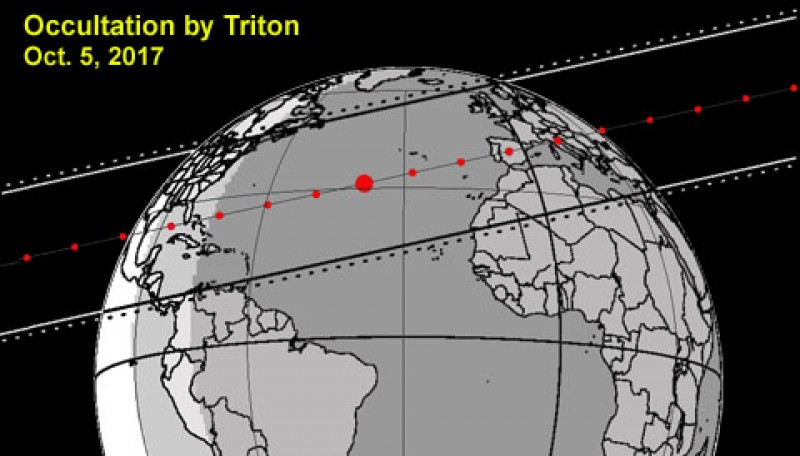For those of us who keep track of where and when solar-system objects occult a background star, the brief cover-up of a dim star in Aquarius by Neptune’s large moon Triton on October 5th was especially newsworthy.

The path of Triton's stellar occultation on October 5 passed over many observing stations.
Bruno Sicardy / Observatoire de Paris
The target, 12.6-magnitude star UCAC4 410-143659, was the brightest star occulted by Triton since 1997. It’s about a magnitude brighter than Triton itself, and its location only 13 arcseconds from 8th-magnitude Neptune made observations relatively easy.
The 1997 occultation, and some of the faint stars occulted a few years later, had shown that Triton experienced significant global warming since the Voyager 2 flyby in 1989. New observations would determine if the trend had continued.
Observers recorded the October 5th event from more than 65 stations in Europe, the UK, northern Africa, and the United States, making it the best-observed occultation by any object with an atmosphere.
NASA’s Stratospheric Observatory for Infrared Astronomy (SOFIA), as well as at least 15 observers in Europe close to the centerline of the occultation’s path, recorded the central flash. This brief brightening occurs as the star passes behind Triton, and the atmosphere all around the moon focuses the light of the star. Observations of the central flash are especially important since they probe a deeper level of the atmosphere than the gradual disappearances and reappearances of the star recorded by observers elsewhere in the path of Triton’s shadow.
Even though we’ve known about this event for years, an updated prediction based on new astrometric observations shifted the path significantly south just one day before it happened.
Wolfgang Beisker, of the International Occultation Timing Association’s European Section (IOTA/ES), traveled from Germany to Portugal to record the central flash with an 11-inch Schmidt-Cassegrain telescope. Beisker’s light curve, which shows the central flash rising to about half the unocculted star’s brightness, can be seen on IOTA / ES’s website. But it turned out that the actual centerline was more than 100 km farther north. A recording made by Rui Gonçalves with a 50-cm telescope at the Centro Ciência Viva de Constância in central Portugal reveals a central flash that rose to more than twice the star’s unocculted brightness, as can be seen in his processed light curve below.

This record of Triton’s October 5th stellar occultation shows a very strong central flash (described in the text). The turquoise curve is the combined light of Triton and the occulted star, while yellow shows the normalized flux of a comparison star.
Rui Gonçalves & David Dunham / IOTA
SOFIA, normally based in California, flew first to Florida and then out over the Atlantic Ocean for this occultation. According to Michael Person (MIT), scientists aboard the flying observatory successfully recorded the occultation with a central flash at four different wavelengths.
On occultation night, SOFIA climbed to the nominal altitude of 38,000 feet only for the team to realize that not only were there still layers of cirrus clouds above them, but that they also were in an environment saturated with water vapor making it unsafe for the telescope to observe. Without batting an eyelid, Person recounts, the NASA pilots requested clearance to climb to 40,000 feet, which to their surprise was still not clear of the clouds. Finally, after burning some fuel and gaining further altitude, at 43,000 feet SOFIA’s doors could be safely opened and observations could begin.
Planetary Tomography
Besides the central-flash observations, star-disappearance chords are needed at a variety of latitudes across Triton’s disk to determine any oblateness that might exist in the moon’s atmosphere. Fortunately, a good spread of observations were obtained. Using a 10-inch telescope at his home in Newark, New York, IOTA’s Brad Timerson recorded the northernmost chord, apparently only about 90 km “inside” Triton’s north pole. The southernmost chords, well south of the center of Triton, were recorded at Marrakesh Observatory in Morocco and in Tunisia.
More than 55 of the observations were made on the east side of the Atlantic — in the UK, Portugal, Spain, France, Morocco, Germany, Italy, Switzerland, Slovakia, and Tunisia. Paris Observatory’s Lucky Star project coordinated the European effort. It was fortunate that skies were clear enough across much of western Europe, though many observers in northern France and northern Germany reported clouds and rain.
In the United States, besides Timerson’s observation in New York, at least five observatories in Massachusetts (coordinated by MIT’s occultation team) recorded the occultation.
Not everyone celebrated success. Frustratingly, after a long run of clear nights, clouds moved in across the Mid-Atlantic region from Pennsylvania to Virginia just in time for the occultation. The occultation was observed from two sites in western North Carolina, one of them a visual observation with a 32-inch telescope.

A sampling of chords showing the disappearance (left edge) and reappearance (right edge) of the star occulted by Neptune's large moon, Triton, on October 5, 2017.
Brad Timerson / IOTA
Clouds again thwarted observers organized by the Southwest Research Institute (SWRI) and the University of Virginia, several using large portable telescopes. A handful of these observers witnessed the occultation from sites in northern Florida and southern Georgia. But they were not able to record the central flash as they had hoped, since the central line was over southern Florida — where it stayed very cloudy.
Above is Brad Timerson’s very preliminary sky-plane plot of Triton derived from only a few of the early observations, most obtained from the European Planoccult list server. It was difficult to define a consistent level near Triton’s surface for the plot.
We're still in the preliminary stages of analyzing the observations. It will be interesting to see the full results of the analysis of the October 5th occultation, to see how the temperature, structure, and other properties of Triton’s atmosphere have changed with Neptune’s seasons.
Source: David W. Dunham